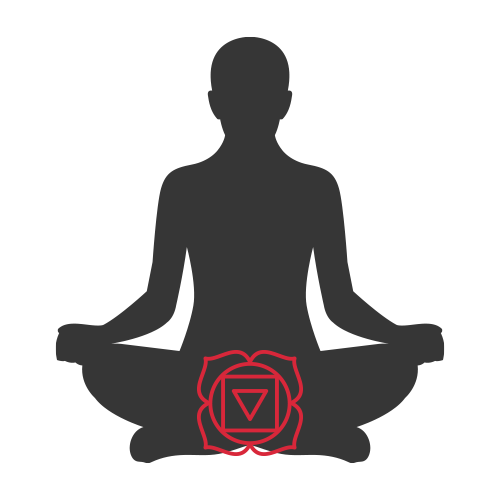Root Chakra work changed my relationship with anxiety in ways I never expected. For years, I thought my constant worry about money, my restless sleep, and that nagging feeling of never quite belonging anywhere were just “personality traits.” It wasn’t until I started studying the chakra system that I realized these weren’t character flaws—they were signs of an energy center crying out for attention.
If you’ve ever felt like you’re floating through life without an anchor, or if you find yourself constantly worried about basic security, you’re probably dealing with root chakra imbalances. And you’re definitely not alone in this.
Root Chakra Basics: Understanding Your Energetic Foundation

The root chakra, known in Sanskrit as Muladhara (which literally means “root support”), sits at the base of your spine like the foundation of a house. Just as a building needs solid ground to stand on, your entire energetic system depends on this first chakra being stable and strong.
When I first learned about the seven main energy centers (see: 7 Chakras: Introduction to Energy Centers and Their Effects), I was skeptical about the root chakra’s importance. “How can something I can’t see affect my daily life?” I wondered. But here’s what I discovered: this energy center governs everything that makes you feel safe and secure in the world.
Think about Maslow’s hierarchy of needs for a moment. Food, shelter, safety, belonging—these fundamental requirements for human thriving are exactly what the root chakra represents energetically. When this chakra is balanced, you feel:
- Financially secure (even if you’re not rich)
- Physically safe in your environment
- Connected to your family and community
- Confident about meeting your basic needs
- Grounded and present in your body
The Ancient Wisdom Behind Root Chakra Understanding
The concept of Muladhara appears in ancient Tantric texts dating back over 1,000 years, but the experiences it describes are timeless. The Sat Chakra Nirupana, written in the 16th century, describes this chakra as a four petaled lotus flower at the base of the spine, associated with the earth element and the color deep red.
But you don’t need to study Sanskrit to understand what our ancestors were pointing toward. They recognized that humans need to feel rooted—literally connected to the earth and metaphorically grounded in their sense of belonging and security.
What fascinated me most in my research was learning that indigenous cultures worldwide have similar concepts. The Aboriginal Australian idea of “country” as a spiritual foundation, the Native American understanding of our connection to Mother Earth, the African concept of ancestral grounding—these aren’t just cultural ideas. They’re recognitions of something fundamental about human energy and wellbeing.
Modern neuroscience is actually backing up what these ancient traditions knew. Studies on the autonomic nervous system show that when we feel safe and grounded, our parasympathetic nervous system can function properly. We sleep better, digest food more efficiently, and our immune systems work optimally. When we’re in constant fight or flight mode due to feelings of insecurity, everything suffers.
When Your Root Chakra is Out of Balance: Signs You Can’t Ignore

I learned to recognize root chakra imbalances the hard way—by experiencing most of them myself. During a particularly unstable period in my twenties when I was freelancing without steady income, I developed what I now recognize as classic root chakra symptoms.
Physical symptoms were the first red flags:
- Chronic lower back pain that no amount of stretching seemed to help
- Digestive issues that flared up whenever I worried about money
- Restless legs syndrome that made sleep nearly impossible
- Constantly feeling cold, especially in my feet and hands
- Frequent illness—my immune system seemed shot
Emotional and mental signs were harder to connect initially:
- Obsessive worry about finances, even when things were actually okay
- Feeling like I didn’t belong anywhere, despite having friends and family
- Inability to be present—always planning, worrying, or rehashing the past
- Hoarding tendencies (my closet became stuffed with “just in case” items)
- Difficulty making decisions, especially about where to live or work
Behavioral patterns that emerged:
- Overworking to the point of exhaustion because I never felt “secure enough”
- Difficulty trusting others, especially in professional relationships
- Avoiding commitment in relationships because nothing felt stable
- Compulsive shopping when stressed (retail therapy, anyone?)
- Unable to enjoy the present moment because I was always preparing for disaster
Does any of this sound familiar? Here’s what I wish someone had told me earlier: these aren’t personal failings. They’re your energy system’s way of telling you that your foundation needs attention.
The tricky thing about root chakra imbalances is they can go in two directions. Some people become anxious and scattered (like I was), while others become rigid and overly controlling. You might know someone who micromanages everything, who can’t delegate, who needs to control every detail of their environment. That’s often the other side of root chakra imbalance—trying to create safety through excessive control.
The Root Chakra Body Connection: What Your Physical Symptoms Are Telling You
One of the most eye opening aspects of working with the root chakra is how directly it connects to physical health. The base of your spine, your legs, feet, bones, and large intestine all correspond to this energy center.
I remember when my yoga teacher first pointed out that my chronic lower back pain might be related to feeling unsupported in life, not just poor posture. At first, I rolled my eyes. But as I started working with grounding practices and addressing my underlying security fears, the pain genuinely began to improve.
Here’s what’s happening energetically: when you don’t feel safe or supported, your body literally contracts to protect itself. Your psoas muscle (which connects your spine to your legs) chronically tightens. Your pelvic floor becomes either overly tense or too relaxed. Your legs might feel weak or unsteady because you’re not energetically “rooted” to the earth.
This is where specific yoga poses become incredibly powerful for root chakra healing (see: Yoga Warrior Pose Guide). Standing poses like Warrior I aren’t just about building leg strength—they’re about learning to stand your ground, literally and metaphorically.
I’ve worked with students who discovered that their digestive issues improved when they started addressing feelings of not belonging in their families. Others found that their chronic fatigue lifted when they dealt with underlying financial fears. The body mind connection isn’t just a nice idea. It’s demonstrable through chakra work.
Practical Root Chakra Healing: What Actually Works
After years of experimenting with different approaches, I’ve found that root chakra healing works best when you combine physical practices with inner work. You can’t just think your way to feeling grounded, and you can’t just exercise away deep insecurity. It takes both.
Grounding Practices That Make a Real Difference:
The most powerful grounding practice I’ve found is also the simplest: walking barefoot on earth. I know it sounds too basic to be effective, but hear me out. There’s actual science behind this—studies show that direct skin contact with the earth’s surface reduces inflammation and cortisol levels.
But more than the biochemical benefits, there’s something profoundly settling about feeling grass or dirt under your feet. I started with just five minutes in my backyard each morning, and within weeks I noticed I was sleeping better and feeling less scattered during the day.
Gardening has been another game changer. Getting your hands in soil, nurturing plants, watching things grow it all reinforces your connection to the earth element that governs the root chakra. Even a small herb garden on a windowsill can help.
Movement and Yoga for Root Chakra Balance:
Certain yoga poses are particularly effective for root chakra work because they emphasize connection to the ground and stability through the legs. Warrior poses (see: Yoga Warrior Pose Guide) are obvious choices, but I’ve found that slower, more deliberate movements often work better than dynamic flows.
Child’s pose with a focus on feeling supported by the earth beneath you. Standing forward folds where you really feel your feet rooted down. Gentle spinal twists (see: Yoga Twists and Safety Principles) that help release tension from the lower back and stimulate the digestive organs.
The key is approaching these poses with the intention of grounding rather than just going through the motions. I often tell students to imagine roots growing from their tailbone down into the earth, or to visualize drawing up earth energy through their feet.
Working with Fear and Insecurity:
This is where the inner work becomes crucial. Root chakra imbalances often stem from early experiences of not feeling safe or supported. Maybe your family moved frequently when you were young. Perhaps there was financial instability or emotional unpredictability in your household. Or maybe you experienced trauma that shattered your basic sense of safety.
You don’t need to psychoanalyze your entire childhood, but it can be helpful to notice what triggers your feelings of insecurity. For me, it was anything related to money or housing stability. Even small changes in income would send me into panic mode.
One practice that helped enormously was creating what I call “evidence lists.” When I felt insecure about finances, I’d write down all the evidence that I was actually capable of supporting myself—past jobs I’d held, skills I possessed, friends who would help in a crisis. This wasn’t positive thinking or denial; it was reminding my nervous system of actual facts when fear was distorting my perception.
Nutrition and the Root Chakra:
Red foods have a special connection to root chakra healing—beets, red peppers, pomegranates, tomatoes. But more important than color is eating in a way that feels nourishing and grounding. Regular meals, adequate protein, foods that give you sustained energy rather than quick spikes and crashes.
I noticed that my root chakra symptoms always worsened when I was eating erratically or surviving on coffee and anxiety. Taking time to prepare real meals, eating, sitting down rather than standing at the counter, paying attention to how foods made me feel, All of this became part of my grounding practice.
The Connection Between Root and Solar Plexus Chakras
Something I wish I’d understood earlier is how intimately connected the root chakra is to the solar plexus chakra—your center of personal power and confidence (see: Manipura Chakra: Solar Plexus Chakra). When you don’t feel secure in your basic survival needs, it’s nearly impossible to step into your personal power.
I spent years wondering why I couldn’t seem to advance in my career or speak up for myself, not realizing that my shakiness came from deeper down—from not feeling fundamentally safe and supported. It wasn’t until I worked on grounding and security that I could access real confidence.
This is why many traditional approaches to chakra work start from the bottom up. You establish your foundation first, then build upward. It’s hard to work on self expression or spiritual connection when you’re worried about keeping a roof over your head.
Advanced Root Chakra Work: When Basic Practices Aren’t Enough
Sometimes despite your best efforts with grounding practices and yoga poses, root chakra imbalances persist. This might be a sign that you need deeper work around clearing energetic blockages (see: How to Unblock Chakras).
Trauma informed therapy can be incredibly helpful, especially approaches like somatic experiencing that work with the nervous system. EMDR therapy has helped many people release stored trauma that keeps the root chakra contracted.
Energy healing modalities like acupuncture, Reiki, or craniosacral therapy can also be powerful supplements to your personal practice. I’ve seen students make breakthrough progress when they combined their daily grounding practices with professional energy work.
Sometimes the issue isn’t just personal but generational. If your family lineage includes stories of displacement, poverty, or persecution, you might be carrying inherited trauma patterns in your root chakra. Working with a therapist who understands family systems or even exploring your ancestral history can provide important context and healing opportunities.
Living with a Balanced Root Chakra: What Changes
When your root chakra is functioning well, life feels fundamentally different. Not perfect—you’ll still face challenges and uncertainties—but your relationship to those challenges changes.
You sleep better because your nervous system trusts that you’re safe. You make decisions from a place of groundedness rather than fear. Money becomes a tool rather than a source of panic. You can be present in your relationships instead of constantly scanning for threats or escape routes.
I remember the first time I realized my root chakra was healing. I was facing a work deadline and potential financial stress—the exact type of situation that used to send me into overwhelm. Instead of my usual anxiety spiral, I found myself calmly making a plan and trusting that I could handle whatever came up. My body felt solid and present rather than scattered and shaky.
This doesn’t mean becoming complacent or ignoring real problems. A balanced root chakra actually helps you respond more effectively to challenges because you’re not wasting energy on imaginary threats or past traumas.
Integration with Daily Life: Making Root Chakra Work Sustainable
The practices that have sustained me long term are simple enough to integrate into daily life without requiring major schedule overhauls. Morning grounding—even just two minutes with bare feet on grass. Eating at least one meal per day sitting down without distraction. Taking three conscious breaths whenever I notice anxiety rising.
I also learned to pay attention to my environment. Cluttered, chaotic spaces drain root chakra energy, while organized, clean environments support it. This doesn’t mean your home needs to look like a magazine—it means creating spaces that feel safe and nurturing to you.
Building community and connection is another ongoing practice. The root chakra represents not just individual survival but tribal belonging. Regular contact with people who care about you, participation in community activities, even having neighbors you know by name—all of this feeds your sense of belonging and security.
The Bigger Picture: Root Chakra Work as Spiritual Practice
Working with your root chakra isn’t just about feeling less anxious or sleeping better, though those benefits are wonderful. It’s about creating a stable foundation for your entire spiritual and personal development.
When you feel genuinely secure and grounded, you have energy available for creativity, love, self expression, and spiritual growth. You can take healthy risks because you trust your ability to handle whatever happens. You can be present with others because you’re not constantly monitoring your own safety.
This is why the root chakra is considered the foundation of the entire chakra system. Just as you can’t build a house on unstable ground, you can’t develop the higher chakras fully without first establishing this energetic foundation.
The journey of root chakra healing taught me that spirituality isn’t about transcending the physical world—it’s about being fully present in it. Feeling your feet on the earth, trusting your body’s wisdom, creating safety in your daily life—these are profoundly spiritual practices that create the stability needed for all other growth.
Whether you’re just beginning to explore chakra work or you’ve been on this path for years, remember that healing happens in layers. Be patient with the process. Your nervous system learned its patterns of fear and contraction over years or even decades. Healing takes time, consistency, and compassion for yourself.
Start where you are, with whatever feels manageable. Walk barefoot when you can. Breathe consciously when you remember. Trust that your body knows how to heal when given the right conditions. Your root chakra is waiting to support you—you just need to give it the attention and care it deserves.
Frequently Asked Questions about Root Chakra (Muladhara)
The Root Chakra, or Muladhara in Sanskrit, is located at the base of your spine near the perineum. It’s the first and foundational energy center that governs your sense of safety, security, and basic survival needs.
Common signs include chronic anxiety about money or safety, lower back pain, digestive issues, feeling ungrounded or scattered, difficulty sleeping, and a persistent sense of not belonging anywhere. Physical symptoms often manifest in the legs, feet, and lower spine.
Root Chakra blockages typically stem from early life experiences of instability, trauma, financial insecurity, frequent moving, family dysfunction, or any situation that threatened your basic sense of safety and belonging.
Effective natural methods include walking barefoot on earth, grounding exercises, eating red foods, practicing Warrior poses (see: Yoga Warrior Pose Guide), gardening, creating stable routines, and working with feelings of insecurity through therapy or journaling.
Red foods like beets, pomegranates, red peppers, and tomatoes support Root Chakra healing. More importantly, focus on regular, nourishing meals with adequate protein that provide sustained energy and help you feel grounded.
Grounding poses like Warrior I, Mountain Pose, Child’s Pose, standing forward folds, and gentle twists (see: Yoga Twists and Safety Principles) are particularly effective when practiced with the intention of connecting to the earth.
Root Chakra healing varies by individual and depends on the depth of imbalances. Some people notice improvements in weeks with consistent practice, while deeper trauma patterns may take months or years to fully resolve.
Yes, since the Root Chakra is your energetic foundation, imbalances here can destabilize your entire chakra system. It’s particularly connected to the Solar Plexus Chakra (see: Manipura Chakra: Solar Plexus Chakra), as security issues often impact personal confidence.
Root Chakra practices focus on energetic grounding and body-based healing, while therapy addresses psychological patterns. For deep trauma, combining both approaches with professional support (see: How to Unblock Chakras) often produces the best results.
Consistent grounding practices like daily barefoot walking, regular meals, stable routines, community connection, and creating a secure living environment help maintain Root Chakra balance over time.
